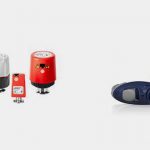Many pneumatic valves are fairly straightforward things — they’re open, or they’re shut, and it’s pretty clear when they should be in each position. But 3-position pneumatic valves with double-acting cylinders can be confusing.
3-position pneumatic valves are able to stop an attached pneumatic cylinder in mid-stroke, either ceasing motion or — their intended purpose — ‘jogging’ the cylinder for a heartbeat in mid stroke before continuing to extend or retract normally.
Often, such complexities are requested when they’re not needed, because the engineer designing the system believes that such a three-position valve is needed as an emergency response: if, for example, power cuts out in mid-job, they believe the third position is a useful way to prevent damage to the system.
In fact, that’s not the case; instead, two-position, detended pneumatic valves should be used on clamps and other devices to maintain cylinder position if power is unexpectedly removed. A spring-return, two-position valve will also work if no pinch point exists or the cylinder is moving in a guarded action and can return to its normal position safely.
The problem with using 3-position pneumatic valves as ’emergency response’ is that there is no position in which such a valve is actually safe during an extended power cut.
- If the valve is in the all-closed position, the cylinder will be pressurized on both sides, which can lead to drift if the cylinder isn’t perfectly sealed.
- If the valve is in the ‘let air in’ position, the cylinder will immediately move toward the extended position because of the higher surface area on the can end of the piston than the rod end.
- If the valve is set to ‘let air out’ position, the cylinder will immediately move toward the retracted position because there will simply be no pressure present to maintain the extension.
There is a fourth scenario — if the 3-position valve is set to ‘let air out’ position and the circuit has a dual pressure system designed to provide ‘make-up’ pressure to overcome any leakage (which almost always comes with check valves in place to keep the cylinder pressurized against unexpected loads), the 3-position pneumatic circuit doesn’t suffer terribly in an emergency outage. However, this is an incidental byproduct of a system created for other purposes, and using a system like this as an emergency measure is expensive and less reliable than the aforementioned system of detended two-position valves and spring-return valves.























